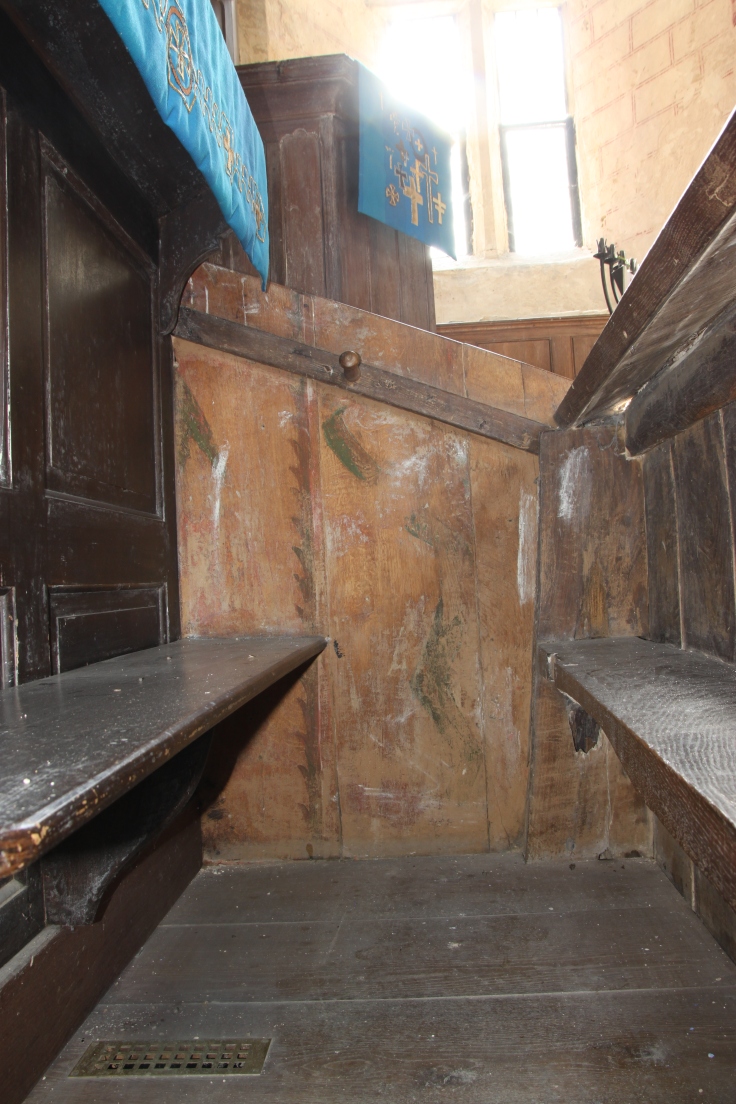
Woodeaton in Oxfordshire has a super little medieval church with lots to delight and catch the interest. The walls have the remains of layer upon layer of medieval wallpaintings, including lots of red ochre lining out on the walls of the nave and a delightful St Christopher facing the main south door, just where you would expect him to be. The wallpaintings have all been carefully conversed in recent years. There is also a very late medieval rood screen, perhaps early Tudor, it’s dado of linenfold panelling painted a striking red and green and pierced with elevation squints. Medieval benches sit alongside box pews and there are hatchments and a west gallery. A wonderful example of the organic development of a medieval church, as it was equipped for the reformed liturgy.

Above the chancel arch is set a large beam that runs from the north to the south wall, it is shown in the photography above and if you click on this link it will take you through to an image that you can blow up and see in detail. That will let allow you to look closely at the inscription on the beam, that is picked out against a faded ochre background. It appears to read:
‘Venite benedicte patris mea – ite maledicte in ignem eternam’
i.e.
‘Come you blessed of my father – go to the eternal fire, you accursed’
This inscription, with it’s references to salvation and damnation, is a paraphrase of parts of Matthew 25. Between the fierce words, are delicate sprigs of foliage and there is a large gap at the midpoint between to the two clauses of the text.
Given the subject matter of the inscription, which is Christ addressing the saved and damned, the beam is most probably the rood beam that supported the image of Christ crucifed. I can’t, however, believe that it’s current position is the original one. The roof of the nave is 17th or 18th century and this earlier beam appears to have been reused as a tie beam. My suspicion is that the beam was further down the wall, midway up the height of the chancel arch and on top of a rood loft now gone.
The inscription, broken clearly into two clauses (salvation to the left, damnation to the right), would make good sense if it was viewed in conjunction with an image of judgement, a doom scene. There is no evidence that there was a doom at Woodeaton, but if the beam was indeed originally set lower down on this wall, you could image a doom painted on a boarded tympanum set into the chancel arch, similar to those that remain at Penn and at Wenhaston.


If you examine the 17th and 18th century pews that are in front of the rood screen and the pulpit, you will find the remains of what appears to be a wooden tympanum, cut up for reuse as pew partitions. The curved edge and the close boarding of the tympanum are evident, matching the curve of the chancel arch and the boards bear traces of colour that match the early 16th-century pigment on the rood screen. Sadly the pigment is vague and thee imagery painted on this tympanum fragment cannot be made out to prove either way – which is both tantalising and deeply frustrating.

I originally wrote a post on this subject matter in 2009, this is an updated and more considered version after revisiting and photographing this church once again. In my first visit I hadn’t spotted the tympanum fragment.


Nice St Christopher. Maybe the rood beam inscription, which assumes quite a level of literacy for a medieval rural congregation – or priest, for that matter – is a pendant to the Doom? Could the Doom still be up there, behind layers of whitewash, or is the visible painted-in masonry of too early a date to allow for this? Looks as though it may well be early.
LikeLike
I had thought the same, except that the lined out masonry is, I think, contemporary with the figure of St Christopher, so about a hundred years earlier.
LikeLike
This comment has been removed by the author.
LikeLike
Of course there is a the possibility that a wooden tympanum was applied over the masonry lines, like the ones that remain at Penn in Buckinghamshire and at Dauntsey in Wiltshire. The doom tympanum at Penn occupies a similar position, considerably above the chancel arch.
LikeLike
Ah, a very springy, lively expressive drawing for that period. I assume the artist is unknown. Thanks.
LikeLike
Digging around online looking for information about Opus Anglicanum, I found this blog. It’s really terrific. That Christopher figure is fantastic — the layers and fading of the paint along with the texture of the papers gives this St. Christopher an ethereal “fragile-ness” with which he’s not usually associated. The featureless face of the Christ figure he carries gives it unintentional poignancy, as well. It would interesting to see something like this stabilized but not restored and let time itself have a hand in the art-making…
LikeLike
Sorry to comment so long after the original post, but you might be interested to know that the clerks stall (facing into the nave on the south side) has a side panel made from painted boards. It seems likely these boards are part of an old Doom that went with this rood beam. You can still see the outlines of figures on them. More boards, similarly painted and removed from the church some years ago, were recently found in storage in Oxford. The parish is also fundraising for roof repairs at the moment, so if you pop in any time soon do leave them a little something!Nat (DAC sec, Diocese of Oxford)
LikeLike